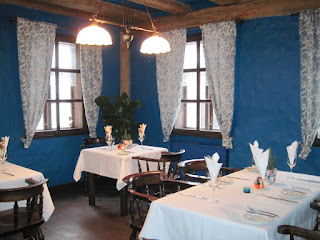The snows of December portrayed Liepaja like a fairy tale. Buildings that I passed daily for 4 months took on a fresh new beauty, bathed in light. It was a magical time that I will never forget.
Students in my classes asked why I chose Latvia. I responded that there were two key reasons. First, my father's doctor, whom he liked and admired deeply, had fled his beloved homeland during medical school. He completed his degree in Germany. At the close of WWII he and his wife chose not to return to Latvia where they could not be free. After making a new life for himself in America, he returned to visit Latvia after it regained independence in the early 1990s. So I came to Latvia in memory of Dr. Azeris.
The other reason is more personal and relates to my career. Americans are very blessed, and many of us (particularly the young) feel a sense of entitlement. We "deserve" everything nice, as we wish it.
I wanted to know what inner fire had maintained the Latvian spirit throughout decades of forced occupation and oppression. What preserved their hopes for a life of freedom?
So I asked my students, "Where does that strength come from?"
They replied in the voice of their elders, "We never give up. We never give up."
If you have enjoyed and learned from this blog, please visit again. You can see it's become a retrospective, but it's very important to me to document what I experienced and learned. And I hope you will consider possibilities for foreign service and international travel. It will change your life immeasurably, for the better!
Best wish,
Kay Dennis
Students in my classes asked why I chose Latvia. I responded that there were two key reasons. First, my father's doctor, whom he liked and admired deeply, had fled his beloved homeland during medical school. He completed his degree in Germany. At the close of WWII he and his wife chose not to return to Latvia where they could not be free. After making a new life for himself in America, he returned to visit Latvia after it regained independence in the early 1990s. So I came to Latvia in memory of Dr. Azeris.
The other reason is more personal and relates to my career. Americans are very blessed, and many of us (particularly the young) feel a sense of entitlement. We "deserve" everything nice, as we wish it.
I wanted to know what inner fire had maintained the Latvian spirit throughout decades of forced occupation and oppression. What preserved their hopes for a life of freedom?
So I asked my students, "Where does that strength come from?"
They replied in the voice of their elders, "We never give up. We never give up."
If you have enjoyed and learned from this blog, please visit again. You can see it's become a retrospective, but it's very important to me to document what I experienced and learned. And I hope you will consider possibilities for foreign service and international travel. It will change your life immeasurably, for the better!
Best wish,
Kay Dennis

















































